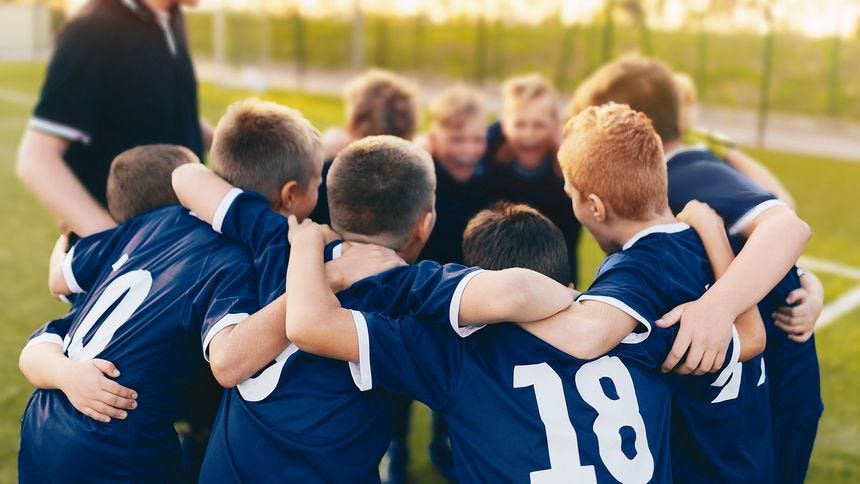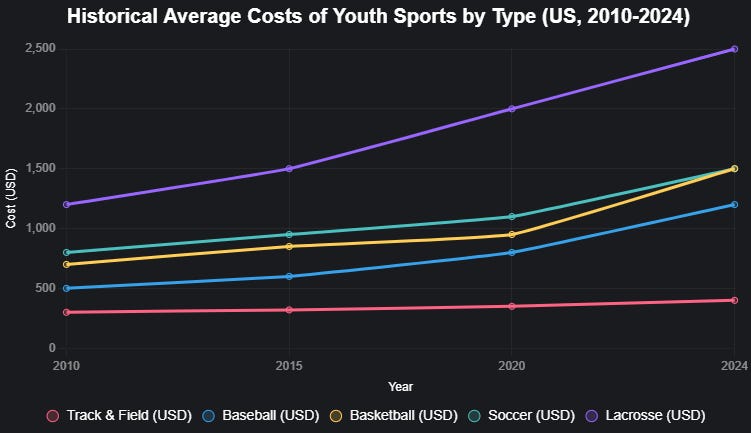The Shifting Landscape of Youth Sports: Is the Game Over for the Rec Sports for the Next Generation?

It’s a crisp fall Saturday in 2023, and I’m standing on a dusty field at South Cherokee Baseball Park in Woodstock (Georgia) cheering as my oldest son—then 9 years old - throws a heater from the mound in a rec team baseball game. No high-pressure travel ball, just kids in slightly oversized jerseys, some forgetting which base to run to, and parents more focused on bringing the right game chair than RBIs. It takes me back to my own childhood in South Carolina, where baseball meant pickup games in empty lots or little league games at Trenholm Park. Nobody was scouting us for the majors; it was about teamwork, fresh air, the thrill of a good hit, and buddies.
Fast forward to today, and a Vice article caught my eye on X: “Is This the End of Youth Sports?” It paints a stark picture of private equity turning kids’ games into profit-driven enterprises, pricing out families, and draining the fun from play [1]. As a dad to two active boys (now 11 and almost 12) who’ve also tried youth lacrosse, football, running club, soccer, and paintball at Bear Ridge, this hits home. Digging deeper, I found reports confirming a decline in participation, especially in Georgia where elite “travel” programs are becoming symbols of the cost barrier. Is this just the little league free market doing its thing, or are we letting costs and pressures rob our kids of a childhood staple?
The Decline: What’s Happening to Youth Sports?
Youth sports have long been a cornerstone of American childhood, but the numbers tell a troubling story. The Aspen Institute’s Project Play 2024 report notes a 6% drop in core team sports participation among kids aged 6-17 from 2019 to 2022—about 1.2 million fewer kids playing [2]. The COVID-19 pandemic didn’t help, with participation plummeting nearly 50% at its peak[3].
To visualize this, consider the chart below, which tracks core participation rates (regular team sports play) for youth ages 6-17 from 2019 to 2023, based on data from the Sports & Fitness Industry Association (SFIA) and Aspen Institute surveys. It shows a steady erosion, with rates dipping below 40% by 2023—the lowest in over a decade for many demographics.
Historically, youth sports flourished post-World War II, building character and community. Think 1950s Little League or the Title IX-driven boom for girls in the 1970s. But now? The Vice article nails it: private equity is muscling in. Firms like Unrivaled Sports, backed by billionaires Josh Harris and David Blitzer, are buying up leagues and facilities, turning them into cash cows [1]. As Vice puts it, “It’s Little League meets the depressing dystopia of late-stage capitalism. Where nothing can be good and pure anymore” [1].
The SFIA 2025 Participation Report shows overall activity rates at 80%—solid, but deceptive. Girls’ participation is climbing, while boys’ is tanking, especially among low-income families where only 25% of boys play [4]. Black children’s involvement has also dropped sharply [5]. In affluent areas, a 2025 study from Peter Gray’s Substack shows 70% of kids from high-income families (over four times the poverty level) participate, compared to much lower rates for others [6]. It’s a divided landscape: the wealthy pay for elite programs, while others sit on the sidelines.
Post-COVID, new challenges emerged. A 2025 Project Play survey found parents reporting kids lost about a week of practices or games in 2024 due to extreme heat from climate change [7]. A 2024 study in *Frontiers in Sports and Active Living* highlights how pandemic restrictions disrupted youth sports, with many kids never returning [8]. Civic Science’s 2025 report notes declining equipment spending as families feel the pinch [9].
Why the Drop? Unpacking the Causes
Let’s get to the root of it. “Costs are soaring.” The Vice article points to places like IMG Academy, where tuition hits $85,000 a year for pro-level perks [1]. A June 2025 Sportdecals blog lists rising fees as the top reason for declining participation, alongside burnout from over-specialization [10]. Nationally, the Aspen Institute pegs average family spending at $883 per child annually for basics, but that’s deceptive—total costs, including secondary sports, hit $1,500 in 2024, a 46% jump since 2019 [11]. Travel teams? Up to $25,000 yearly with tournaments and gear [11].
The chart below breaks down average annual costs per child across select sports in 2024-2025, drawing from Aspen and SFIA data. Notice how elite options like soccer or lacrosse dwarf rec-level play—soccer’s $1,188 average includes travel that’s gutting participation for middle-class families.
In Georgia, this hits hard with elite private leagues like East Cobb Baseball, a Marietta powerhouse with 61 teams under 18 and a rep for 283 national titles. But the entry fee? A cool $400 just to register, plus tryouts, uniforms, and travel that can push seasonal costs to $2,000-$5,000 per kid—far beyond what many families can swing [12]. It’s the “Mecca of travel baseball,” as locals call it.
Other Georgia examples? Look at Atlanta-area soccer clubs like Concorde Fire or Rush Union Soccer—premier programs boasting high-level competition but with fees starting at $1,500-$3,000 for the season, not counting private coaching or out-of-state showcases [13]. Lacrosse outfits like the Georgia Swarm youth feeders or those tied to the A5 Sportsplex in Roswell add another layer, with club dues hitting $2,500+ and tournament travel eating up weekends (and wallets) [14]. Even football leagues like the Georgia Youth Football League (GYFL) or Gwinnett Football League (GFL) are shifting toward pricier models, with tackle programs running $300-$800 upfront, ballooning with gear and camps [15]. These aren’t rec leagues; they’re pipelines to college scouts, but the toll? One Medium piece calls it “the high cost of youth sports,” where lower-income kids are priced out entirely [16].
For my boys, we’re fortunate that both of our sons stuck with non-travel options for sports despite being good enough to try out, play, etc. But I know parents forking over thousands, chasing scholarships that only 2% of high school athletes ever snag [17]. It’s a far cry from the $40 billion youth sports industry nationally, where private equity is snapping up facilities like Georgia’s massive high school stadiums—think the $100 million+ pour into places like McEachern High’s field, one of the priciest in the state [18].
“Burnout is a killer.” Airtalk on LAist reports kids quit by age 11, on average, after just three years [19]. A March 2025 op-ed blames “excessive pressure” for killing youth sports [20]. Many parents, who are trying to “do right” for their kids and mentioned that travel ball practices started feeling like tryouts for the Olympics. We stayed with rec baseball, where he can swing for fun, not glory.
“Access and equity gaps” are glaring. The American Institute for Boys and Men (AIBM) in March 2025 linked boys’ declining participation to broader health and social struggles [21]. Screen time is a fierce competitor; kids are glued to tablets instead of running bases. James Peacock’s 2023 investigation (still relevant) notes socioeconomic divides and fragmentation post-COVID [22]. As adoptive parents, we’ve seen how our boys, with their foster care background, need low-pressure environments. High-stakes sports like East Cobb can trigger anxiety, so we’ve leaned into rec leagues and occasional paintball sessions at Bear Ridge, where they learn teamwork without the stress. Watching my youngest dodge paintballs like he’s in a Hollywood action flick is worth every penny and $20-60 for a session beats $2,000 for a season of elite ball.
Post-COVID Shifts and Future Predictions
COVID threw a wrench in youth sports. A 2020 Aspen Institute piece foresaw renegotiated contracts and innovation, but 2025 data shows uneven recovery [23]. Project Play’s 2023 goal was 63% participation by 2030; we’re at 80% overall, but disparities persist [24].
A 2021 PMC study warns of long-term experiential challenges [25], while Children’s Hospital Los Angeles in July 2025 urges post-COVID health checkups for safe return [26]. Athletes in Action’s 2020 call to reimagine sports—focusing on better than “normal”—feels spot-on [27].
Looking ahead, Vice warns private equity will raise barriers: “With big moneyed interests in charge, the financial barrier is going to rise, pricing out the financially strapped kids” [1]. Yet SFIA’s 2025 report sees potential in multi-sport play [28]. The Youth Sports Business Report flags declining male participation as a threat to the industry [4]. Locally, Cherokee County’s rec programs are rebounding, some like CYFA need restructuring, but Georgia’s elite scene—like East Cobb or Concorde—could widen the gap if costs keep climbing. A 2025 NYT piece pegs the whole industry at $40 billion, with private equity eyeing more M&A in fragmented markets like ours [29]. My prediction: Without pushback, we’ll see more kids in affordable paintball skirmishes than pricey travel tournaments. My kids need more competition anyway…
My unCommon Sense
Personally, I believe youth sports should be about choice, not corporate overreach or government mandates. Parents, not private equity firms, should decide what’s best for their kids. Rising costs signal a market failure, but subsidies invite bureaucracy. Instead, let’s champion community solutions: rec baseball, football, lacrosse, or paintball at Bear Ridge, all volunteer-driven and affordable. My boys thrive in these settings, learning resilience without pressure. As a type 1 diabetic, I know balance is key—exercise keeps me alive, but overdoing it risks long-term decline. Same goes for kids: push too hard, and they burn out.
Parents, don’t live through your kids’ sports. If they love lacrosse, let them stick to Parks and Rec, not drop $3,000 on a club team. Solutions? Cap fees through co-ops, promote multi-sport seasons, and use tech for low-cost virtual coaching. If private equity wants profits from GYFL or GFL expansions, fine—I’ll stick to teaching my boys to hit a curveball in the backyard with a $50 bat from Play It Again sports. Sports build character, but only if kids can play. Let’s prioritize access, fun, and choice—because in Georgia, we’ve got the fields, the talent, and the common sense to make it work without breaking the bank.
Youth sports aren’t dead, but they’re at a crossroads. Whether it’s battling corporate greed or navigating post-COVID hurdles, we can shape a future where kids play for joy, not profit. What’s your experience? Are your kids still swinging bats or dodging paintballs, or have they quit? Share your thoughts.
If you want to have a constructive conversation about this or anything else, reach out to dan@thrailkill.us, and let’s grab coffee or a beer.
Have a good one,
Dan





This is a great article. My son did not play travel anything. I never thought why do I want to $2,000 - $5,000 to play baseball. I believe kids should be kids and have a summer. I think that is why a lot of kids have arm problems, knee problems and much more. Travel teams have buffaloed parents by showing their 1% of athletes that go pro after high school or go play college ball. High School programs use these travel programs to say if you don't do it you are not good enough to play. Which is false. So, let kids have a summer to go the beach, hike or just run around the house. Because, not every kid that goes through the travel programs make it to the next level.
How do you write so much good stuff? Are you levering technology? What is your secret? A parallel story might be the rapid decline of the Boy Scouts, particularly it impact on fatherless boys. Keep writing. Phil.